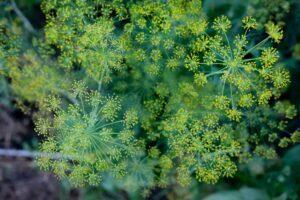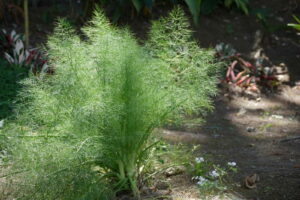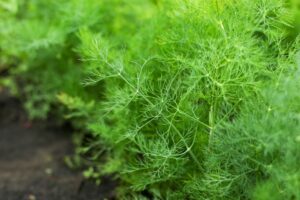Dill is popular with fish dishes and gherkins. Here you can find out what needs to be considered when growing cucumber herb in beds or pots.

dill (Anethum graveolens) has a long tradition of cultivation and use as a spice and also as a medicinal plant. More than 5000 years ago, the umbelliferae (Apiaceae) used and cultivated in Europe specifically for the refinement of dishes. Not only the delicate shoot tips can be used in the kitchen. If the annual plant is allowed to bloom, the disinfecting dill oil can be obtained from the seeds of the dill. But before you can get that far in your grow, there are a few things to consider.
Growing dill - step by step
- Location: Dill can be grown both in beds and in pots. No matter which variant you choose, the cucumber herb always prefers a sunny spot. However, the soil should not be too compacted and wet. When growing in the garden bed, a loamy soil with a certain amount of sand or gravel is therefore advantageous for drainage. A loose, permeable substrate should be chosen in the pot, which nevertheless has a certain water holding capacity. the Plantura Organic Herb & Seed Soil is ideal for this. The vessel should also be high enough. Dill forms a deep-reaching taproot. You should also pay attention to this when choosing a variety. As a rule, it is expressly pointed out if a dill variety particularly suitable for pot culture. Due to some diseases, it is advisable not to grow dill in the same location year after year. A break in cultivation of four years is recommended to give the annoying soil diseases no chance.
- propagation: Dill is only propagated by seed. Outdoors, the seed can be applied directly from April. From March you can also bring young plants indoors and plant them out from May with a growth advantage. The annual herb takes about three weeks to germinate at temperatures of around 15 °C. Although dill needs light to germinate, outdoors the seed should be covered very thinly with substrate to protect it from the wind outdoors. Also, don't sow the seeds too close together. In this way you can save yourself the work step of thinning out seedlings that are too dense.

- Watering and fertilizing: Dill doesn't like it when the moisture level on its roots is too changeable. If the plant is watered too much, a fungal attack is not long in coming. And a constant interplay between desert-dry and moor-wet is not conducive to the successful cultivation of cucumber herb. Therefore, an even and rather restrained supply of water is recommended. When it comes to nutrients, dill is very frugal. It is therefore sufficient to fertilize the plants once a year, for example with the Plantura organic universal fertilizer.
-
Care: Actually, there is not much to consider when caring for the dill. But a few nasty plant diseases and pests can throw a spanner in the works. Viruses can cause stunted growth. With great care, the affected plants can only be removed from the stand, if possible without touching other plants with the diseased ones. In the root area are harmful nematode species and leaf miners above ground and aphids animal pests. unwanted nematodes are difficult to fight. In addition to chemical agents, the use of beneficial insects can be useful against their colleagues on the surface of the earth. So there is no need to worry about the harvest due to pesticide residues. Immediately after the seeds germinate, the so-called casserole disease can massively decimate the stock. Several mushrooms cause the small plants to suddenly fall over. Here, too, the only thing that helps is sorting out and hygiene, or trying whether pesticides can still save the seedlings that are not infested. After the seedlings have survived the critical period and grow up, they can still be eaten by representatives of the fungal genus Fusarium haunted and stretched there. These nasty soil dwellers are also the reason why you shouldn't grow dill in the same spot next year.
Since the dill seedlings develop very slowly, it is important to get rid of wild herbs in the beginning. This is absolutely necessary so they don't overgrow the dill and steal nutrients and water. - Harvest: The young, fresh shoot tips of the dill are harvested. During the culture can be harvested continuously. Once the plant has reached a size of 30 cm, it makes sense to harvest and process the entire plant before flowering. However, the dill can also be made to flower, which appears between May and October, depending on the sowing date. Dill self-seeds at the site and would grow back in place the next year. And also the seeds and inflorescences are used in some cases (See: Harvesting, storing and using dill).
- Storage: The greatest aroma yield is also obtained from dill when it is used directly and freshly harvested. When stored around freezing point and relatively high humidity, dill stays fresh for up to three weeks without losing its aroma. However, like any herb, you can also dry the tips and make them durable. It is also possible to freeze the freshly harvested tender shoots directly and remove them all year round as required.
Are you also an avid dill hobby grower? Then share your experiences with us!

I studied horticulture and am a real village kid. I grow herbs, sweet fruit and vegetables, using only organic products. In addition to my love of nature, I love to cook - preferably with fresh vegetables from my garden, of course.
Favorite fruit: elder and raspberries
Favorite vegetables: black cabbage, artichokes and asparagus
previous posts

Dill (Anethum graveolens) has a long history as a spice. We show how..

Dill (Anethum graveolens) is the only species of the dill genus (Anethum). A little variety...

Dill is a tried and tested herb in the kitchen and even has healing properties. Here..



